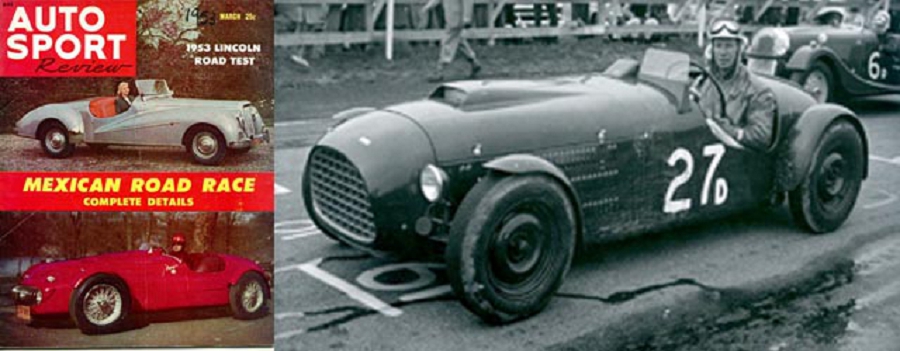
Hi Gang…
This is another in a series articles on the 1949 Edwards R26 sports car. You can review all stories about this and other Edwards sports cars here on Forgotten Fiberglass by clicking here.
I’ve been focusing on the Sterling Edwards 1949 R26 sports car of late because it influenced expectations across America concerning the promise and design of sports cars in the immediate postwar era. Another reason for covering this now is that the car (the Edwards R26 with its original body but on a completely different chassis) is coming up for auction in November 2011. Click here to read more about the car and the auction near Chicago, Illinois.
As I’ve said before, it’s an exciting time to learn about these early postwar American sports cars, so let’s delve into another aspect of the history of this special car.
How Many Edwards R-26’s Are There? Let Me Count The Ways…
As Mulder, of “X-Files” used to say….”The Truth Is Out There….” In our case, it may just take some digging to get the answer. “What’s the question?” you ask? Here it is:
“What’s the story on the different bodied R-26 cars we see in historic photos?”
Great question! Let’s review.
Parsing the Number of Early Coachbuilt Edwards Race Cars
As we discussed before, the Edwards R-26 Sports Car had two lives under the ownership of Sterling Edwards. By late ’51, the R-26 had been raced for two years, and Edwards was yearning to do something different. No doubt that when fiberglass cars debuted for the first time at the Petersen Motorama in November ’51, the wheels started turning and the concept for Edwards’ next car was born.
Stirling Edwards second car was going to be built on a Henry J chassis and powered by a Chrysler hemi – it was going to be a brute. And to keep the weight off the tires, he went with the revolutionary new material – fiberglass. The name for this new car was a play off of the name of this first car – just a simple reversal of numbers – it was going to be called the “R-62.”
The fiberglass R-62 debuted in April 1952 at the Pebble Beach Road Race, making the R-62 sports car the second sports car / race car Edwards built. (This was first posited by Glenn Brummer and the confirmation is welcome news. Thanks Glenn!) This is an important date to you fiberglass aficionados out there, for it had only been 4 months since fiberglass cars debuted in America for the first time at the Peterson Motorama in November ’51. That’s light speed in terms of completion time, gang.
In just 4 months, Sterling Edwards and his team had accomplished the impossible. Not only was the fiberglass body finished but the car was being raced for the first time in April of ’52 at Pebble Beach. From what we can tell, the Edwards R-62 race car was the first fiberglass bodied race car in the world.
That’s pretty impressive gang!
That also means that the fiberglass bodied R-62 sports car is one of the earliest known fiberglass cars to emerge in the 1950’s – and probably the first fiberglass bodied race car too. Future research will provide additional information, to either support or detract from this point.
Performance of the Edwards R-62:
From the start, the new R-62 sports car was not performing as it had been expected. I’m sure Edwards’ team was frustrated in every way. According to Phil Remington in a recent interview, this lack-luster performance bolstered their desire to return to their first car – the R-26 – and make it a better performer. They could most easily do this by shedding weight. A new body for the R-26 was about to be born.
While the original R-26 body was built by Emil Diedt of Los Angeles, the new body would be built much closer to Edwards home in San Francisco. He chose Jack Hagemann to build the body, and the project started early in ’52. Within 6 months the new body was ready, making the “new” R-26 a single-purpose racecar. It no longer retained its dual-purpose heritage (sports car / race car) from its original ’49 design.
The original Emil Diedt body that debuted in late ’49 was used on the car until at least August of 1952. At that point, it was shipped to Sterling’s good friend Hamil Reidy of Chicago, Illinois. We assume that Reidy is the one that bodied it on the Henry J chassis and installed a Jaguar engine – but more research is needed concerning the “second life” of this body.
The new Hagemann body appeared for the first time on the original R-26 chassis in the November 8th, 1952 race at Madera Airport. This makes the Hagemann rebodied R-26 chassis the “third” racecar by some definitions, or simply the second iteration of the R-26 since it retained its original chassis – and perhaps original powerplant too (still researching).
So the “order of go” concerning Edwards’ coachbuilt race car history is as follows:
- December 1949: Debut of R-26 with Emil Diedt body. For now, we’re calling this car: R-26A
- April 1952: Debut of R-62 fiberglass bodied sports car. Called the R-62
- November 1952: Debut of R-26 with Jack Hagemann body. For now, we’re calling this car R-26B
Let’s take a look at pictures of the Hagemann bodied R-26
Hagemann Bodied R-26 Edwards Race Car:
I’ve only located two pictures of this car. One appears in the 1995 book “The American Hot Rod” by Dean Batchelor and the other appears in Auto Sport Review, March 1953 with a nice picture. Undoubtedly there are more pictures out there. If any of you have photos of this car, let me know if you would like to share them with our readers of Forgotten Fiberglass 🙂
Here are the pictures:
1952 Race History of R-26A, R-26B, and R-62
Here is the known race history of Sterling Edwards three cars for 1952 only (click here to review the full race history discussed here on Forgotten Fiberglass):
——————-
1952:
- Race 1: March 23, 1952 Palm Springs #? Overhead valve V8 60 so R26 DNF
- Race 2: April 20, 1952: Pebble Beach. Debut of R62 #1 and R26 #26 also entered. R 62 based on Henry J and fabricated components. Powered by modified Chrysler 5510 cc engine and carries a fiberglass body. Sterling Edwards was down to drive each of them. Novice Race class 4 (1900-3000cc) T.H. Reidy 2nd #26 R26. Del Monte Trophy Class 1 (5500-8000 cc) Edwards 2nd #1 R 62. Overall he is not listed in first 11 so may have been 15th in Main with R 62. In 1952 Sterling Edwards entered both R 26 and R 62 at Pebble Beach. Neither one finished and I cannot find any photos. It was the first race for R62.
***Note: First race for fiberglass bodied R62 was in this race – Pebble Beach April 20th, 1952. Confirmed in Motor Sports World, May 2nd, 1952 and Road & Track, July 1952.
- Race 3: May 31, 1952 Golden Gate #? R 62 18th
- Race 4: July 20, 1952 Torrey Pines #26(?) R 62 DNF (described as Chrysler engine)
- Race 5: August 3, 1952 Buchanan DNA?
- Race 6: August 24, 1952 Stockton Junior Aid Trophy #26 R 62 Motor Sport World 3rd in report and 5th in chart so ?????. R&T shows 3rd as does SC 11/12 52 pg 11, distant photo pg 10
- Race 7: August 24, 1952 Stockton #26 R62 “Chrysler Special” main 5th. Photo in SC 11/12 52 pg 13 of “Fiberglass R 26” !
- Race 8: November 9, 1952 Madera #26 R?? finish? After this race Sterling Edwards switched to his C Jag then to his Ferraris and did not race an Edwards Sports Car (R-26 or other) again.
***Note: Race 8 on November 9th, 1952 was the first race for R-26 with Hagemann body. Confirmed in Auto Sport Review, March 1953 and Motor Sports World, December 5, 1952.
——————-
Summary:
As we’ve been able to best determine, the R-26B with new Hagemann body continued to be raced, but not by Sterling Edwards after the Madera race concluded. We’re still in the process of confirming with photographic evidence if it raced into ’55 and/or ’56. As always, research continues.
But that’s not the end of the story of the R-26. The car continued with prominence under new stewardship – something we’ll discuss in the next story about the Edwards R-26 legacy.
Hope you enjoyed the story, and until next time…
Glass on gang…
Geoff
——————————————————————-
Click on the Images Below to View Larger Pictures
——————————————————————-
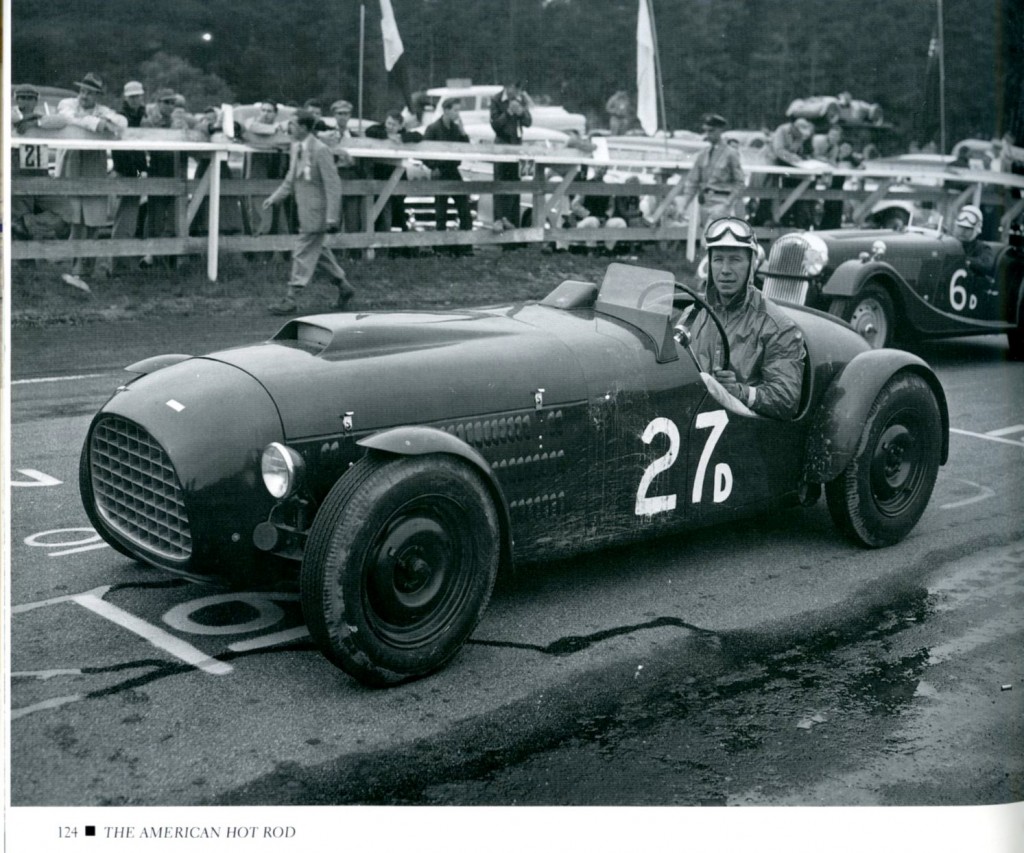
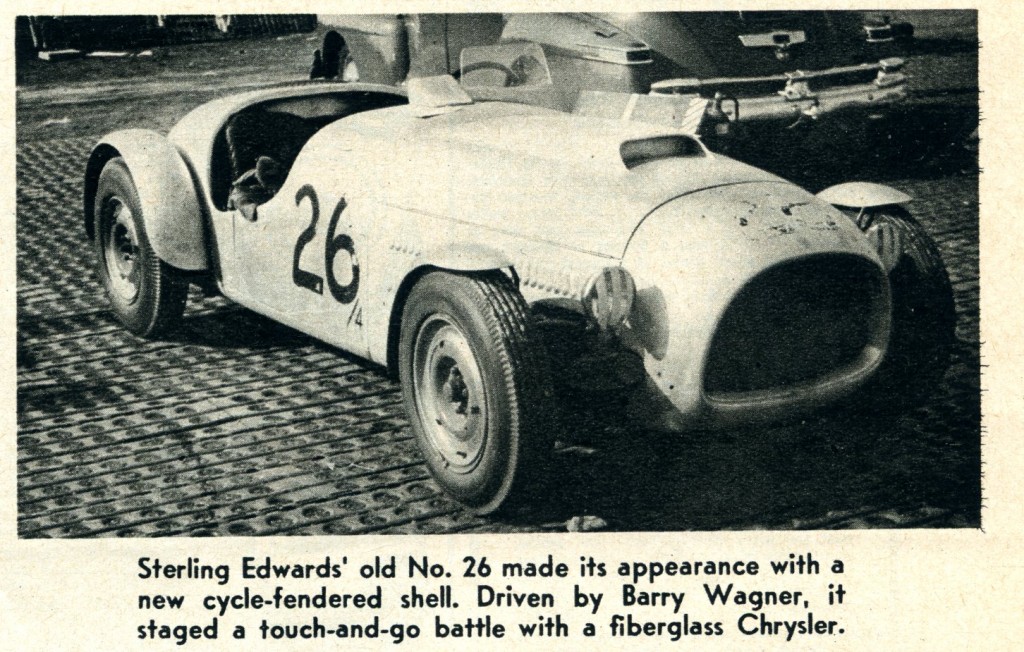

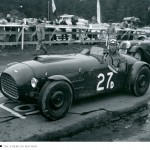
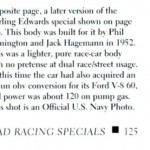
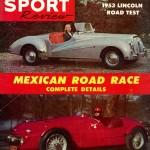
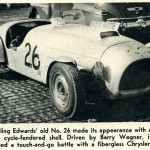

Anxiously awaiting the follow-up story, as you have told me many times was forthcoming… “But that’s not the end of the story of the R-26. The car continued with prominence under new stewardship – something we’ll discuss in the next story about the Edwards R-26 legacy.”
James…Great comments and thanks for sharing your thoughts. Phil Remington confirms that everything was shipped to Chicago – as best as he can recall. Phil said there would have been no reason to keep those parts or separate them from the original body. Thanks again for your contributions. Geoff Hacker
It’s interesting, but odd that some consider the Hagemann bodied R26 a “third” car since it is the R26 – only the body has been changed to extend its competitive life.
Reduced weight and a lowered center of gravity resulted from the lighter body and seats that were no longer chair height – as shown in the completed yet to be bodied chassis photo on page 171 in the Automobile Quarterly article written by Robert Devlin published in 1986 (24/2). Light weight, ease of maintenance, pared down cost all contributed to make cycle fendered sports car specials very much the norm for club racers in the fifties. Relatively short courses without long high speed straights diminished the advantage of a lower coefficient of drag with envelope body work.
The above photo of the R26 with race number 27D (SCCA class D) is published in the Automobile Quarterly article as I’m sure you know. I have found a photo of R26 with the Hagemann body though it’s barely discernible on the grid for the 1953 Pebble Beach Del Monte Trophy race on page 76 of Robert Devlin’s “Pebble Beach – a matter of style”. It is listed as the Edwards R26 Special (in ’50 & ’51 with the Deidt body it was listed as the Edwards Special) it’s in row seven of the two abreast line up just behind the Manning Special. The Edwards R62 is also positioned on the left side of the two by two grid in row three behind four Allards in rows one and two. The R62 fared poorly finishing 9th with the R26 Special 7th.
We know that the original body for the R26 is on the “Hartung Edwards” (or the Reidy Special with Deidt/Edwards body). Since the Deidt body has found a home on the Reidy Henry J chassis that’s probably the best place for it. If someone located the R26 with its Hagemann body
intact (or fabricated a replica Hagemann body) that would be great although I’m sure some would want to reunite the R26 with its original body. Just as I’d like to see the Pinin Farina coupe body that was removed from a Ferrari 212 reunited with the 212 it belongs on and the newly fabricated open body moved onto something else to create a special.
Do you know if the original windshield and hardtop for the Deidt body were shipped to Reidy in Chicago or were they left in California?
In the early post war years there were several sports car specials built with this style cycle fendered bodies, Many were based on MG T chassis or MG and Morris parts, and 2 very well known Simca specials. Several of them had bodies done by panel beaters that generally did open wheeled race car work. Even prewar cars were built into sports racers here and in Europe do to the shortage of new cars. The Brits have a tirm – Cut and Shut – for shortened wheel bases of passenger cars to convert them into sports cars.
Hi Tom…Glad you enjoyed it. I think it’s important to trace the lineage of this car and what forms it took. I have another story coming up on the next owner and its racing history thru the early ’60s – when it disappeared. Thanks for the kind words Tom. Geoff
Geoff,
I’m glad to see you do an in-depth story of this chassis. I was confused about the cycle-fendered car.It’s extremely unusual that a full-fendered modern body would be replaced by an early style cycle- fendered body. That’s not how Ferrari did it !
It’s the R-62. They were both in the same race. More about the R-62 in future stories here 🙂
Can anyone expand on the “fiberglass Chrysler” mentioned in the last photo caption? Chrysler power? Chrysler chassis with ‘glass shell? Or?